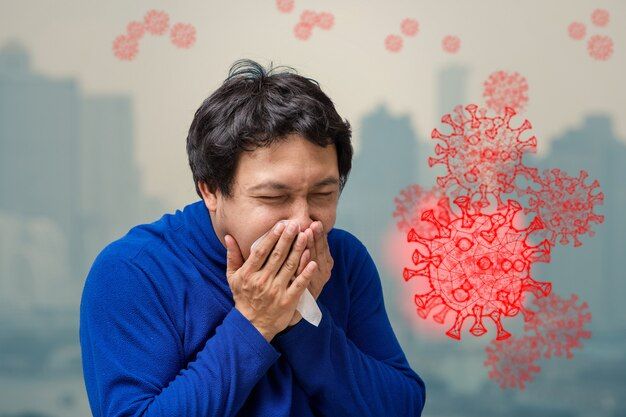
Get A Quote
Are All Infectious Diseases Contagious? A Simple Guide to Understanding Illness Spread
It’s a season when infectious diseases are spreading all over around, do you know how to protect yourself from getting these diseases? there are differences among them, are all infectious diseases contagious? not really, some of them are communicable while some are spreading by other means, in this article we will have a closer look at what are the spreading ways of infectious diseases, and how to against them.

What Are Infectious Diseases?
Infectious diseases encompass a spectrum of disorders initiated by various organisms like bacteria, viruses, fungi, or parasites. These microorganisms, often inhabiting our bodies harmlessly or even beneficially, can turn deleterious under specific conditions, inciting disease. The transmission of these maladies varies; some pass from person to person, others through insects or animals, while some arise from contaminated food, water, or environmental exposure. Signs and symptoms, contingent on the infecting organism, typically involve fever and fatigue. While mild cases may resolve with rest and home care, severe infections necessitate hospitalization.
Vaccination serves as a preventive shield against numerous infectious diseases like measles and chickenpox, while regular and thorough hand hygiene significantly reduces the risk of contracting most infections. These diseases, caused by pathogenic microorganisms, span three categories, varying in mortality rates, disability burdens, and global impact due to their swift and unexpected spread. The determinants and causes of these diseases often transcend the health sector, intertwining with factors related to sanitation, water supply, environmental conditions, and climate change.
How Do Infectious Diseases Spread?
Infectious diseases can spread from person to person. This can happen through direct bodily contact, respiratory droplets (sneezing and coughing), and exposure to contaminated surfaces or objects. Environmental factors like poor hygiene, lack of sanitation, and close living quarters can also contribute to the spread of infectious diseases. And each of the diseases spread in its own way, let’s see how does infectious diseases spread in the following table:
|
Route of Transmission |
Description |
Examples of Diseases |
|
Person to Person |
- Direct contact |
- Common cold - Influenza - COVID-19 |
|
- Indirect contact (via contaminated objects/surfaces) |
- Chickenpox - Measles - Tuberculosis (TB) |
|
|
- Airborne (through droplets or aerosol particles) |
- Common cold - Influenza - COVID-19 |
|
|
Faecal-Oral Spread |
- Transmission through ingesting faecal matter from an infected person |
- Campylobacter - Giardia - Hepatitis A |
|
Blood or Body Fluids |
- Direct contact with infected body fluids (blood, saliva, urine, semen) |
- Hepatitis B - Hepatitis C - HIV |
|
Contact with Skin/Mucous Membrane |
- Direct skin-to-skin contact<br>- Indirect contact through contaminated objects |
- Head lice - Conjunctivitis - Ringworm |
|
Sexual Contact |
- Transmission through vaginal, anal, or oral sex |
- Chlamydia - Gonorrhoea - Syphilis |
|
Environmental Spread
|
- Contaminated Food or Water |
- Listeria - Typhoid - Botulism |
|
- Contact with contaminated environments (animals, insects, soil) |
- Hydatids (animals) - Malaria (insect) - Dengue (insect) - Tetanus (soil) - Legionellosis (compost/soil) |
Are All Infectious Diseases Communicable?
Infectious diseases happen when germs get into the body and spread, causing sickness.
Some contagious diseases can spread through direct bodily contact or contaminated objects, while others are transmitted indirectly, like by mosquitoes or ticks. Not all infectious diseases are contagious, though.
According to Dr. Jackie Smith, an epidemiologist, and Dr. Emma Adam, a veterinarian, although all infectious diseases can't always be passed from person to person, and some are not communicable.
Infectious Diseases Are Not Contagious
Legionnaires' Disease - Transmission occurs by inhaling droplets of water contaminated with Legionella bacteria from sources like showerheads, faucets, hot tubs, and pipes. Not transmitted person-to-person.
Ear Infections - Typically caused by congestion due to illnesses or allergies, allowing germs to grow in the middle ear. Not contagious, as they're not directly spread from person to person.
Urinary Tract Infection (UTI) - Bacterial infection entering the urinary tract through the urethra, often due to bacteria from the rectum. More common in women; sometimes occurs after sexual activity but not exclusively transmitted through sex.
Sinus Infection (Sinusitis) - Often caused by viruses like the common cold, leading to mucus buildup in the sinuses. If viral, it can be contagious, but the sinus infection itself is less likely to spread.
Salmonella Infection - Occurs from consuming contaminated food (commonly raw or undercooked meat, eggs, or poultry) or contact with contaminated surfaces. It's primarily transmitted through contaminated food and not typically person-to-person.
Naegleria fowleri Infection - Caused by an amoeba found in warm freshwater sources like lakes, rivers, and inadequately chlorinated swimming pools. Enters the body through the nose; rare and deadly brain infection.
Rabies - Contracted through the bite of an infected animal like bats, coyotes, dogs, or cats. Rare for humans but fatal if untreated. Not transmitted person-to-person.
Tick-Borne Infections - Ticks can transmit various bacteria and viruses through bites, including Lyme disease, Rocky Mountain spotted fever, Colorado tick fever, and Bourbon virus. Transmission occurs through tick bites and not from person-to-person contact.
Mosquito-Borne Infections - Mosquitoes transmit diseases such as malaria, Zika, West Nile, yellow fever, dengue fever, and chikungunya through their bites. Transmission is via mosquito bites and not directly from person-to-person.
How Do You Test for Infectious Diseases at Home?
Testing for infectious diseases at home has become more accessible with the use of home test kits. These kits are designed to detect specific pathogens or antibodies present in the body through various methods such as saliva, nasal swabs, or blood samples. AICHK stands out as a reliable and trustworthy home test kits supplier, offering a range of options that enable individuals to conveniently and accurately test for infectious diseases from the comfort of their homes. These kits typically come with detailed instructions for sample collection and analysis, providing users with a simple yet effective means to monitor their health and seek appropriate medical guidance when necessary.
Tips to Keep Your Home Safe from Infectious Disease
Infectious diseases can spread within the home through various means. This includes direct contact with an infected person or animal, contact with contaminated objects, consumption of contaminated food or water, and exposure to disease-carrying insects.
Individuals can prevent the spread of infectious diseases within their household by practicing good hygiene, implementing solid insect and parasite controls, and limiting contact with suspect or new animals or people.
To keep the home safe from sick resources, specific actions and precautions include:
Having a good biosecurity plan in place
Controlling access to the property
Providing disposable protective clothing
Furnishing disinfectants for incoming visitors
Taking additional steps to ensure pathogen-free conditions
Prepare enough Rapid Diagnostic Tests for Infectious Diseases at home.


